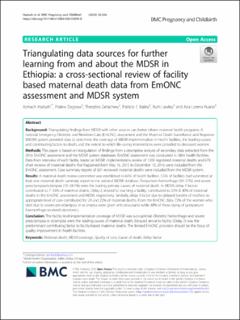| dc.contributor.author | Hadush, Azmach | |
| dc.contributor.author | Dagnaw, Ftalew | |
| dc.contributor.author | Zemedu, Theodros Getachew | |
| dc.contributor.author | Bailey, Patricia | |
| dc.contributor.author | Ruano, Ana Lorena | |
| dc.date.accessioned | 2021-05-11T13:22:47Z | |
| dc.date.available | 2021-05-11T13:22:47Z | |
| dc.date.created | 2021-01-04T10:13:51Z | |
| dc.date.issued | 2020-04-09 | |
| dc.identifier.issn | 1471-2393 | |
| dc.identifier.uri | https://hdl.handle.net/11250/2754974 | |
| dc.description.abstract | Background
Triangulating findings from MDSR with other sources can better inform maternal health programs. A national Emergency Obstetric and Newborn Care (EmONC) assessment and the Maternal Death Surveillance and Response (MDSR) system provided data to determine the coverage of MDSR implementation in health facilities, the leading causes and contributing factors to death, and the extent to which life-saving interventions were provided to deceased women.
Methods
This paper is based on triangulation of findings from a descriptive analysis of secondary data extracted from the 2016 EmONC assessment and the MDSR system databases. EmONC assessment was conducted in 3804 health facilities. Data from interview of each facility leader on MDSR implementation, review of 1305 registered maternal deaths and 679 chart reviews of maternal deaths that happened form May 16, 2015 to December 15, 2016 were included from the EmONC assessment. Case summary reports of 601 reviewed maternal deaths were included from the MDSR system.
Results
A maternal death review committee was established in 64% of health facilities. 5.5% of facilities had submitted at least one maternal death summary report to the national MDSR database. Postpartum hemorrhage (10–27%) and severe preeclampsia/eclampsia (10–24.1%) were the leading primary causes of maternal death. In MDSR, delay-1 factors contributed to 7–33% of maternal deaths. Delay-2, related to reaching a facility, contributed to 32% & 40% of maternal deaths in the EmONC assessment and MDSR, respectively. Similarly, delay-3 factor due to delayed transfer of mothers to appropriate level of care contributed for 29 and 22% of maternal deaths. From the EmONC data, 72% of the women who died due to severe pre-eclampsia or eclampsia were given anticonvulsants while 48% of those dying of postpartum haemorrhage received uterotonics.
Conclusion
The facility level implementation coverage of MDSR was sub-optimal. Obstetric hemorrhage and severe preeclampsia or eclampsia were the leading causes of maternal death. Delayed arrival to facility (Delay 2) was the predominant contributing factor to facility-based maternal deaths. The limited EmONC provision should be the focus of quality improvement in health facilities. | en_US |
| dc.language.iso | eng | en_US |
| dc.publisher | BMC | en_US |
| dc.rights | Navngivelse 4.0 Internasjonal | * |
| dc.rights.uri | http://creativecommons.org/licenses/by/4.0/deed.no | * |
| dc.title | Triangulating data sources for further learning from and about the MDSR in Ethiopia: a cross-sectional review of facilitybased maternal death data from EmONCassessment and MDSR system | en_US |
| dc.type | Journal article | en_US |
| dc.type | Peer reviewed | en_US |
| dc.description.version | publishedVersion | en_US |
| dc.rights.holder | Copyright The Author(s) 2020 | en_US |
| dc.source.articlenumber | 206 | en_US |
| cristin.ispublished | true | |
| cristin.fulltext | original | |
| cristin.qualitycode | 1 | |
| dc.identifier.doi | 10.1186/s12884-020-02899-8 | |
| dc.identifier.cristin | 1864576 | |
| dc.source.journal | BMC Pregnancy and Childbirth | en_US |
| dc.source.pagenumber | 1-9 | en_US |
| dc.identifier.citation | BMC Pregnancy and Childbirth. 2020, 20, 206 | en_US |
| dc.source.volume | 20 | en_US |

